In Situ Synchrotron X-ray Micro-Diffraction Investigation of Elastic Strains in Laminated Ti-Al Composites
Abstract
1. Introduction
2. Materials and Methods
3. Results
3.1. Deviatoric Strains in Al
3.2. Lattice Strains Along ND in Al
3.3. Deviatoric Strains in Ti
3.4. Lattice Strains Along ND in Ti
4. Discussion
4.1. Deviatoric Strain vs Lattice Strain
4.2. Effect of Layered Structure
4.3. Elastic-Plastic Transition
5. Conclusions
- The polychromatic DAXM technique is capable of not only revealing the local variation of the deviatoric strain in the Ti-Al LMC but also of providing a good estimate of the magnitude of the average deviatoric strain (ε′TA = 3.5 × 10−4 for Al and ε′TA = 1.86 × 10−3 for Ti after a tensile strain of 1.66%). The monochromatic DAXM technique is capable of determining the absolute lattice strain component in the Ti-Al LMC, showing large spatial and temporal variations during tensile loading.
- There is a reasonable agreement between the average values of the estimated deviatoric strain and measured lattice strain, especially when the calculated average hydrostatic strain is considered. These average strains are consistent with the loading condition and are generally within the limits set by the flow stresses of Al and Ti.
- The variation of the elastic strain near the interfaces in Al layers is larger than that in the middle of the layer during tensile loading, showing a strong influence of the interface constraint to the Al layers. This is caused by the high initial dislocation density near the interfaces and the requirement of activating dislocations with a wide variety of Burgers vectors to accommodate the strain near the interfaces.
- The residual elastic strain is found to be large in the Al layers and small in the Ti layers compared to their elastic limits, respectively. The local variation of residual strain plays an important role in the micro-plasticity of the Ti-Al LMC sample during tensile loading, leading to a gradual elastic-plastic transition.
Supplementary Materials
Author Contributions
Funding
Institutional Review Board Statement
Informed Consent Statement
Data Availability Statement
Conflicts of Interest
References
- Lesuer, D.R.; Syn, C.K.; Sherby, O.D.; Wadsworth, J.; Lewandowski, J.J.; Hunt, W.H. Mechanical behaviour of laminated metal composites. Int. Mater. Rev. 1996, 41, 169–197. [Google Scholar] [CrossRef]
- Wu, H.; Fan, G. An overview of tailoring strain delocalization for strength-ductility synergy. Prog. Mater. Sci. 2020, 100675. [Google Scholar] [CrossRef]
- Kümmel, F.; Hausöl, T.; Höppel, H.W.; Göken, M. Enhanced fatigue lives in AA1050A/AA5005 laminated metal composites produced by accumulative roll bonding. Acta Mater. 2016, 120, 150–158. [Google Scholar] [CrossRef]
- Du, Y.; Fan, G.; Yu, T.; Hansen, N.; Geng, L.; Huang, X. Laminated Ti-Al composites: Processing, structure and strength. Mater. Sci. Eng. A 2016, 673, 572–580. [Google Scholar] [CrossRef]
- Ohsaki, S.; Kato, S.; Tsuji, N.; Ohkubo, T.; Hono, K. Bulk mechanical alloying of Cu–Ag and Cu/Zr two-phase microstructures by accumulative roll-bonding process. Acta Mater. 2007, 55, 2885–2895. [Google Scholar] [CrossRef]
- Li, D.; Fan, G.; Huang, X.; Juul Jensen, D.; Miao, K.; Xu, C.; Geng, L.; Zhang, Y.; Yu, T. Enhanced strength in pure Ti via design of alternating coarse- and fine-grain layers. Acta Mater. 2021, 206, 116627. [Google Scholar] [CrossRef]
- Ma, M.; Huo, P.; Liu, W.C.; Wang, G.J.; Wang, D.M. Microstructure and mechanical properties of Al/Ti/Al laminated composites prepared by roll bonding. Mater. Sci. Eng. A 2015, 636, 301–310. [Google Scholar] [CrossRef]
- Yu, T.; Du, Y.; Fan, G.; Xu, R.; Barabash, R.; Hansen, N.; Huang, X.; Zhang, Y. In-situ synchrotron X-ray micro-diffraction investigation of ultra-low-strain deformation microstructure in laminated Ti-Al composites. Acta Mater. 2021, 202, 149–158. [Google Scholar] [CrossRef]
- Withers, P.J.; Bhadeshia, H.K.D.H. Residual stress. Part 1–measurement techniques. Mater. Sci. Technol. 2001, 17, 355–365. [Google Scholar] [CrossRef]
- Huang, M.; Xu, C.; Fan, G.; Maawad, E.; Gan, W.; Geng, L.; Lin, F.; Tang, G.; Wu, H.; Du, Y.; et al. Role of layered structure in ductility improvement of layered Ti-Al metal composite. Acta Mater. 2018, 153, 235–249. [Google Scholar] [CrossRef]
- Poulsen, H.F. An introduction to three-dimensional X-ray diffraction microscopy. J. Appl. Crystallogr. 2012, 45, 1084–1097. [Google Scholar] [CrossRef]
- Reischig, P.; King, A.; Nervo, L.; Viganó, N.; Guilhem, Y.; Palenstijn, W.J.; Batenburg, K.J.; Preuss, M.; Ludwig, W. Advances in X-ray diffraction contrast tomography: Flexibility in the setup geometry and application to multiphase materials. J. Appl. Crystallogr. 2013, 46, 297–311. [Google Scholar] [CrossRef]
- Larson, B.C.; Levine, L.E. Submicrometre-resolution polychromatic three-dimensional X-ray microscopy. J. Appl. Crystallogr. 2013, 46, 153–164. [Google Scholar] [CrossRef]
- Abdolvand, H.; Wright, J.; Wilkinson, A.J. Strong grain neighbour effects in polycrystals. Nat. Commun. 2018, 9, 171. [Google Scholar] [CrossRef]
- Barabash, R.I.; Liu, W.; Tischler, J.Z.; Bei, H.; Budai, J.D. Phase-specific elastic/plastic interface interactions in layered NiAl-Cr(Mo) structures. Acta Mater. 2012, 60, 3279–3286. [Google Scholar] [CrossRef]
- Larson, B.C.; Yang, W.; Ice, G.E.; Budai, J.D.; Tischler, J.Z. Three-dimensional X-ray structural microscopy with submicrometre resolution. Nature 2002, 415, 887–890. [Google Scholar] [CrossRef]
- Levine, L.E.; Larson, B.C.; Yang, W.; Kassner, M.E.; Tischler, J.Z.; Delos-Reyes, M.; Fields, R.J.; Liu, W. X-ray microbeam measurements of individual dislocation cell elastic strains in deformed single-crystal copper. Nat. Mater. 2006, 5, 619–622. [Google Scholar] [CrossRef]
- Phan, T.Q.; Levine, L.E.; Lee, I.F.; Xu, R.; Tischler, J.Z.; Huang, Y.; Langdon, T.G.; Kassner, M.E. Synchrotron X-ray microbeam diffraction measurements of full elastic long range internal strain and stress tensors in commercial-purity aluminum processed by multiple passes of equal-channel angular pressing. Acta Mater. 2016, 112, 231–241. [Google Scholar] [CrossRef]
- Tischler, J.Z. Reconstructing 2D and 3D X-ray orientation maps from white-beam laue. In Strain and Dislocation Gradients from Diffraction: Spatially-Resolved Local Structure and Defects; Barabash, R., Ed.; Imperial College Press: London, UK, 2014; pp. 358–375. [Google Scholar]
- Zhang, Y.; Barabash, R. High Resolution Mapping of Orientation and Strain Gradients in Metals by Synchrotron 3D X-ray Laue Microdiffraction. Quantum Beam Sci. 2019, 3, 6. [Google Scholar] [CrossRef]
- Witt, W. Absolute Präzisionsbestimmung von Gitterkonstanten an Germanium- und Aluminium-Einkristallen mit Elektroneninterferenzen. Zeitschrift fur Naturforsch. Zeitschrift für Naturforschung 1967, 22, 92–95. [Google Scholar] [CrossRef]
- Pawar, R.R.; Deshpande, V.T. The anisotropy of the thermal expansion of α-titanium. Acta Crystallogr. Sect. A 1968, 24, 316–317. [Google Scholar] [CrossRef]
- Ice, G.E.; Barabash, R.I. White Beam Microdiffraction and Dislocations Gradients. In Dislocations in Solids; Elsevier Science: New York, NY, USA, 2007; Volume 13, pp. 499–601. [Google Scholar]
- Barabash, R.I.; Barabash, O.M.; Ojima, M.; Yu, Z.; Inoue, J.; Nambu, S.; Koseki, T.; Xu, R.; Feng, Z. Interphase strain gradients in multilayered steel composite from microdiffraction. Metall. Mater. Trans. A Phys. Metall. Mater. Sci. 2014, 45, 98–108. [Google Scholar] [CrossRef]
- Zhou, G.; Pantleon, W.; Xu, R.; Liu, W.; Chen, K.; Zhang, Y. Quantification of local dislocation density using 3D synchrotron monochromatic X-ray microdiffraction. Mater. Res. Lett. 2021, 9, 183–189. [Google Scholar] [CrossRef]
- Chen, Z.; Bong, H.J.; Li, D.; Wagoner, R.H. The elastic-plastic transition of metals. Int. J. Plast. 2016, 83, 178–201. [Google Scholar] [CrossRef]
- Hanson, A.W. Elastic behavior and elastic constants of zinc single crystals. Phys. Rev. 1934, 45, 324–331. [Google Scholar] [CrossRef]
- Chalmers, B. Micro-plasticity in crystals of tin. Proc. Math. Phys. Eng. Sci. 1936, 156, 427–443. [Google Scholar] [CrossRef]
- Maaß, R.; Derlet, P.M. Micro-plasticity and recent insights from intermittent and small-scale plasticity. Acta Mater. 2018, 143, 338–363. [Google Scholar] [CrossRef]
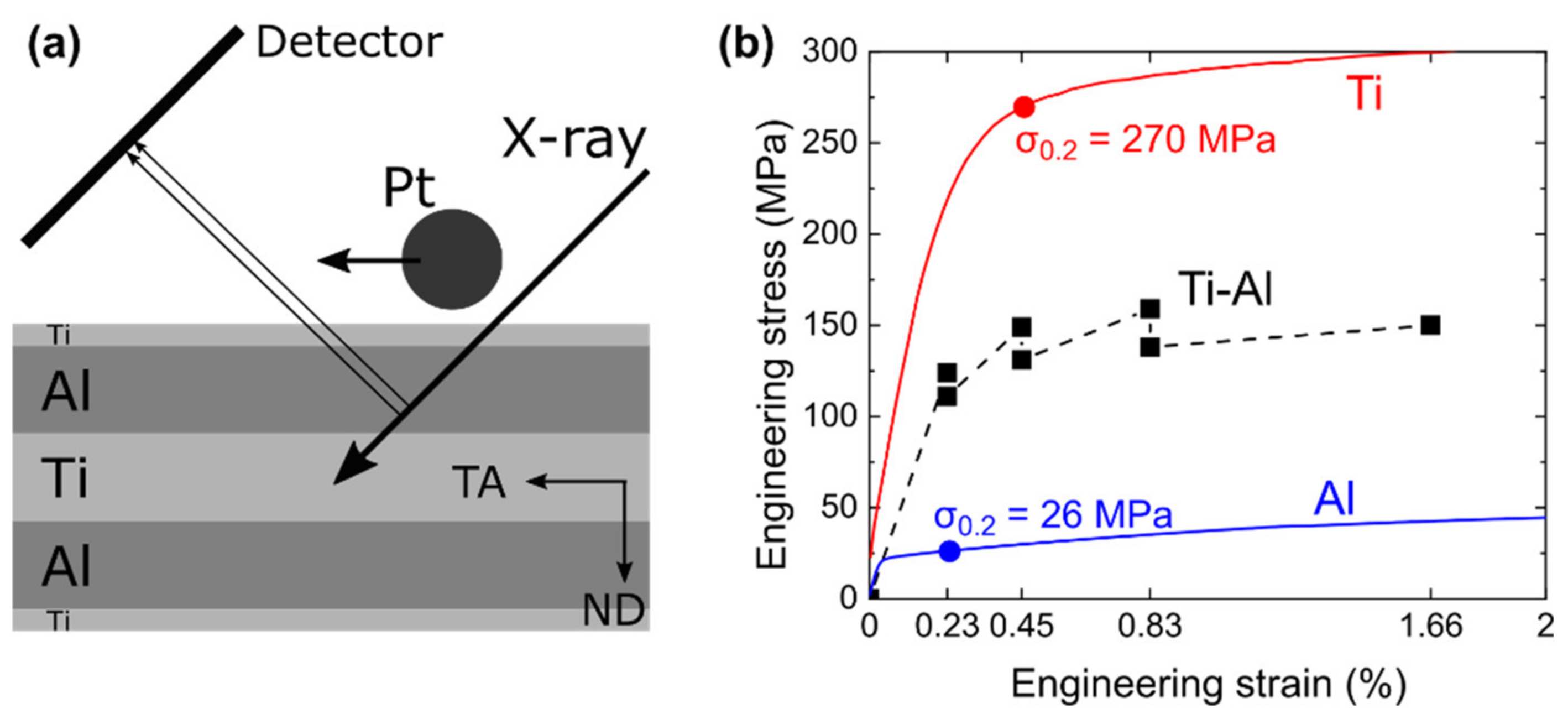

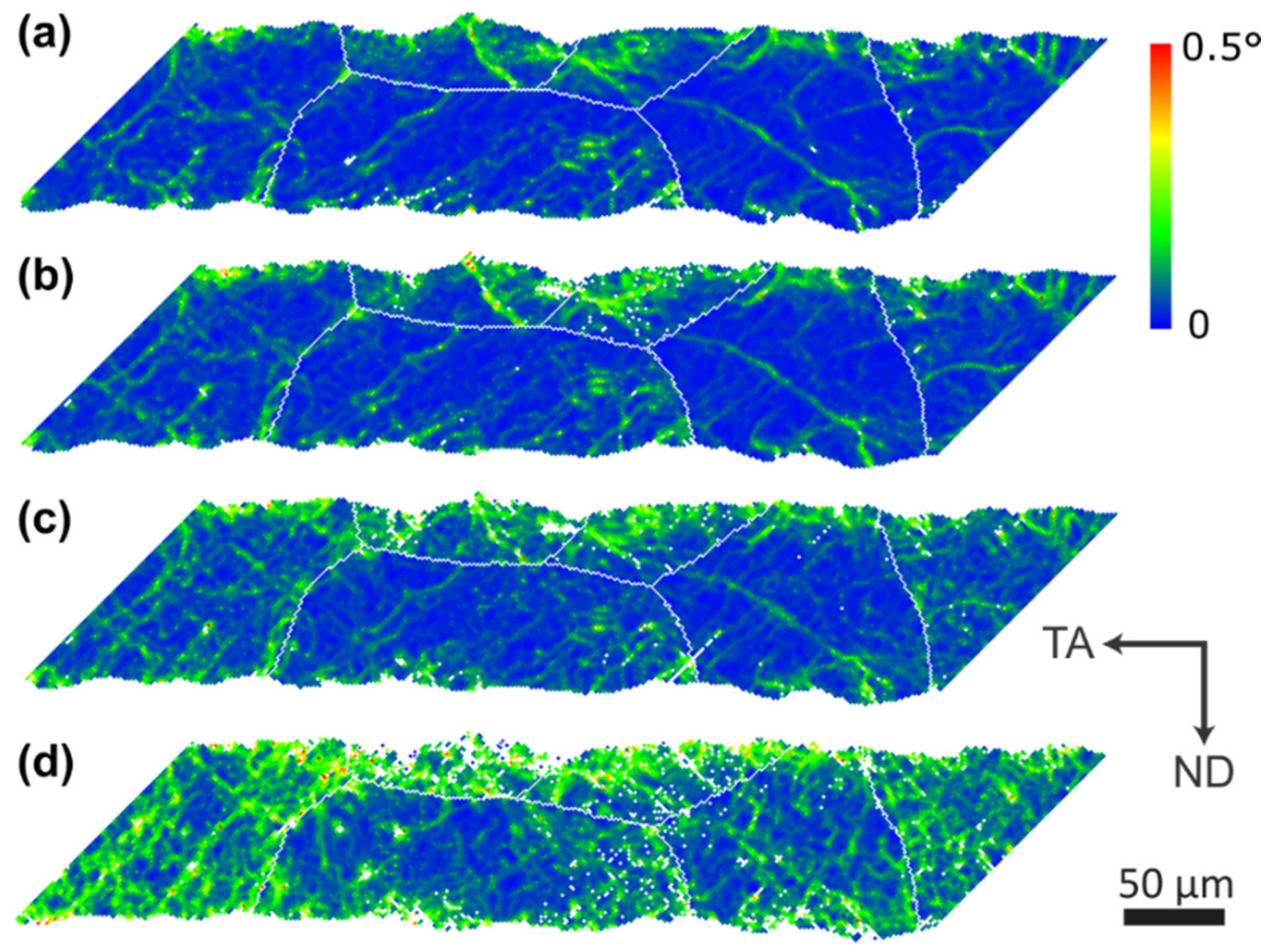
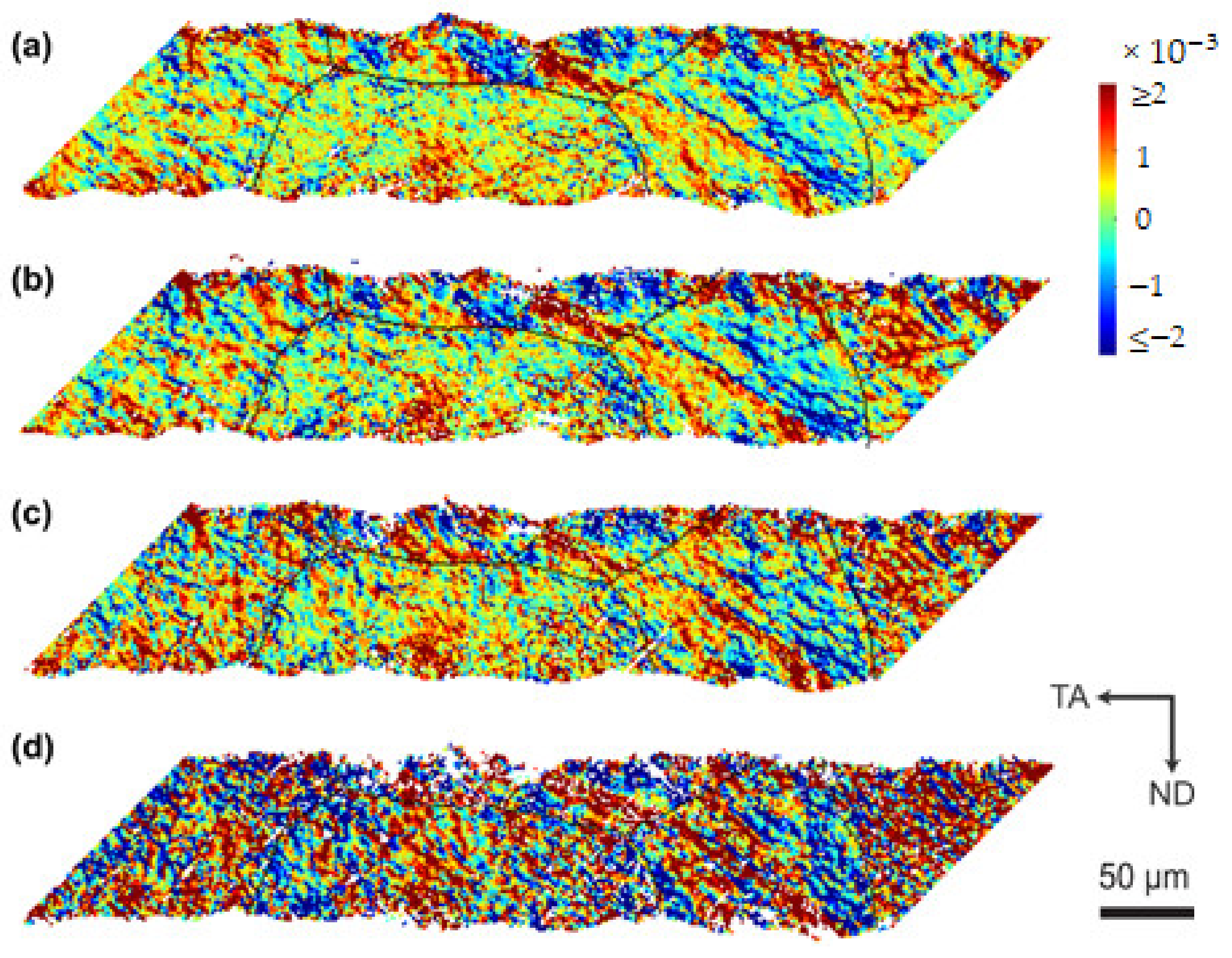
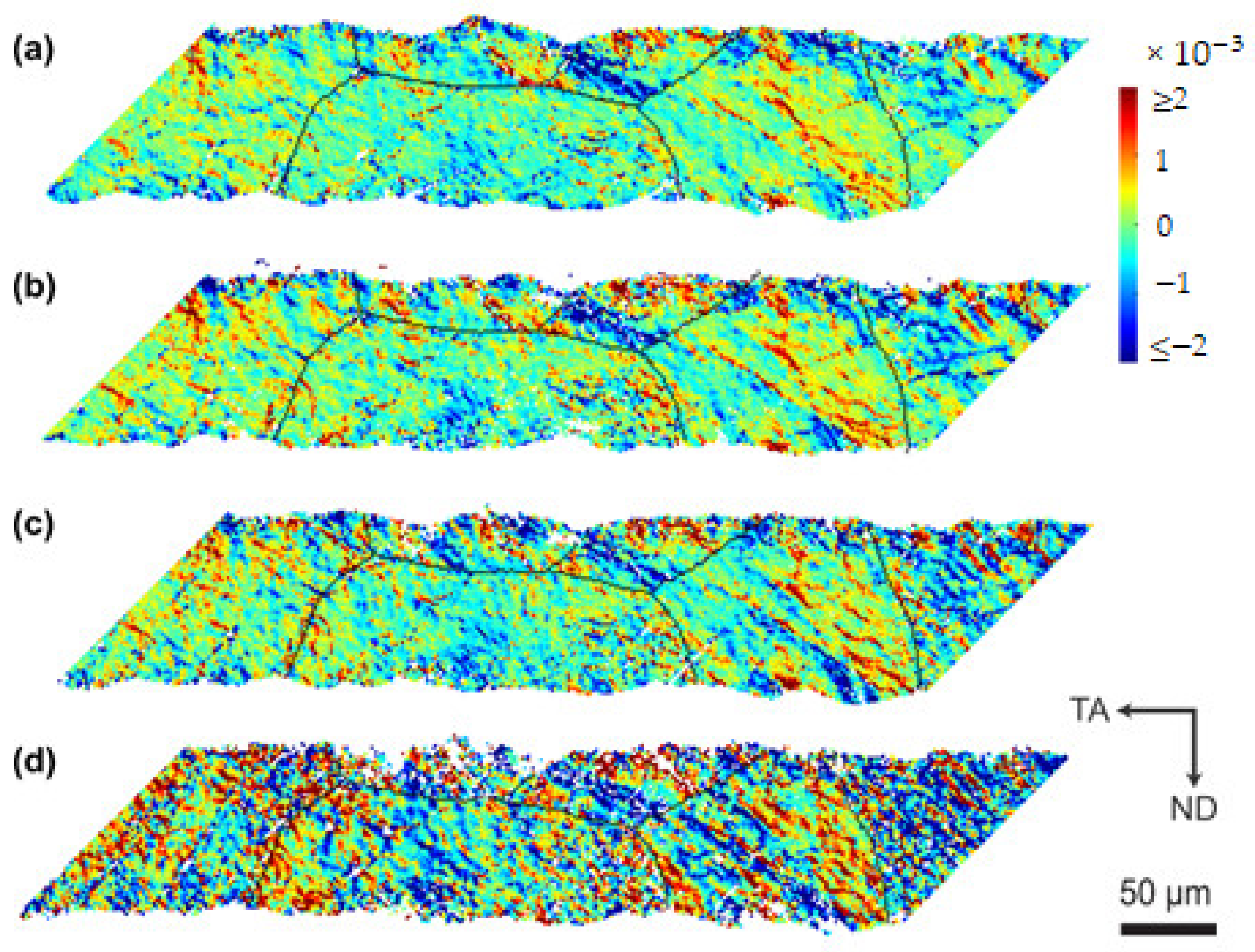
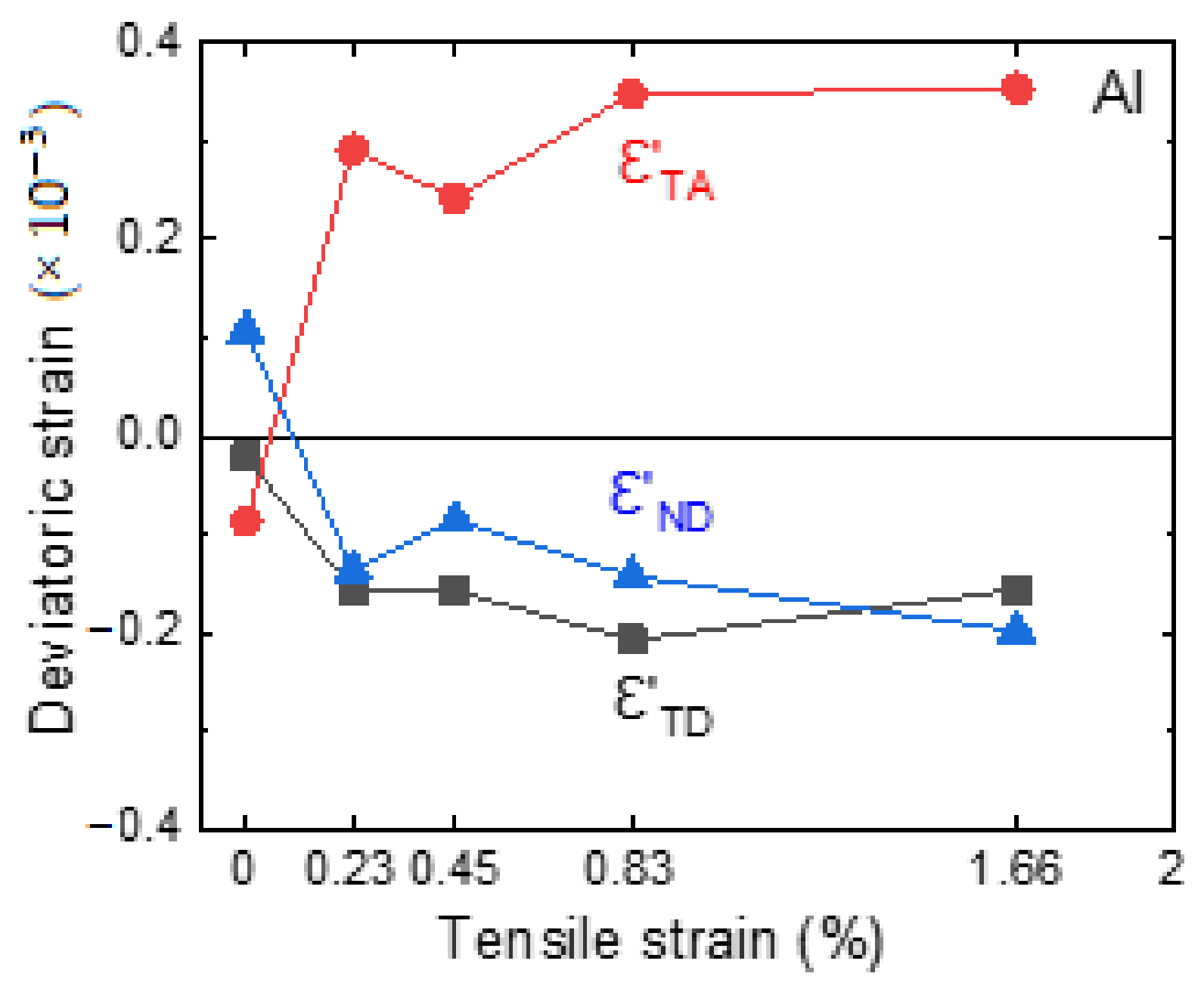
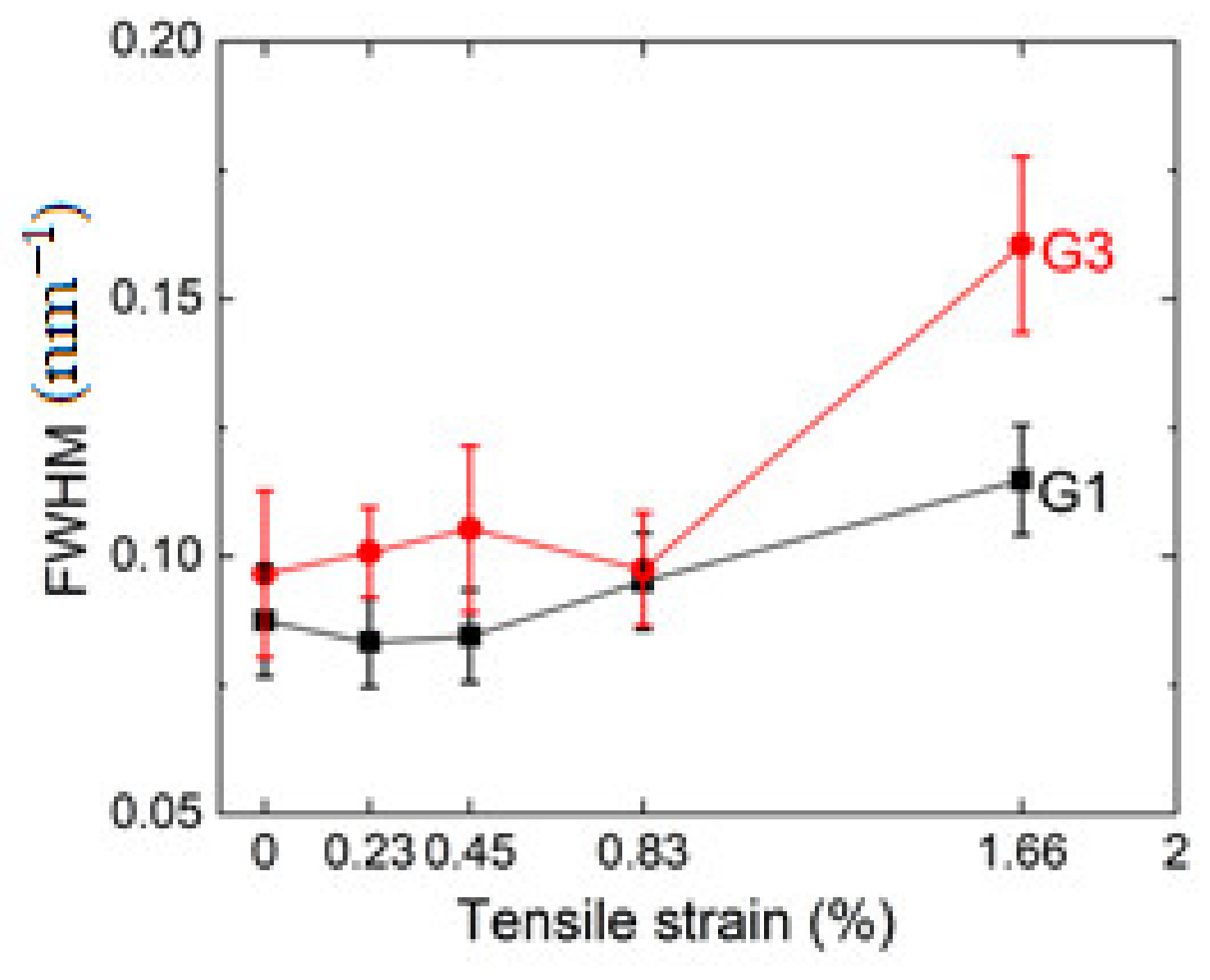
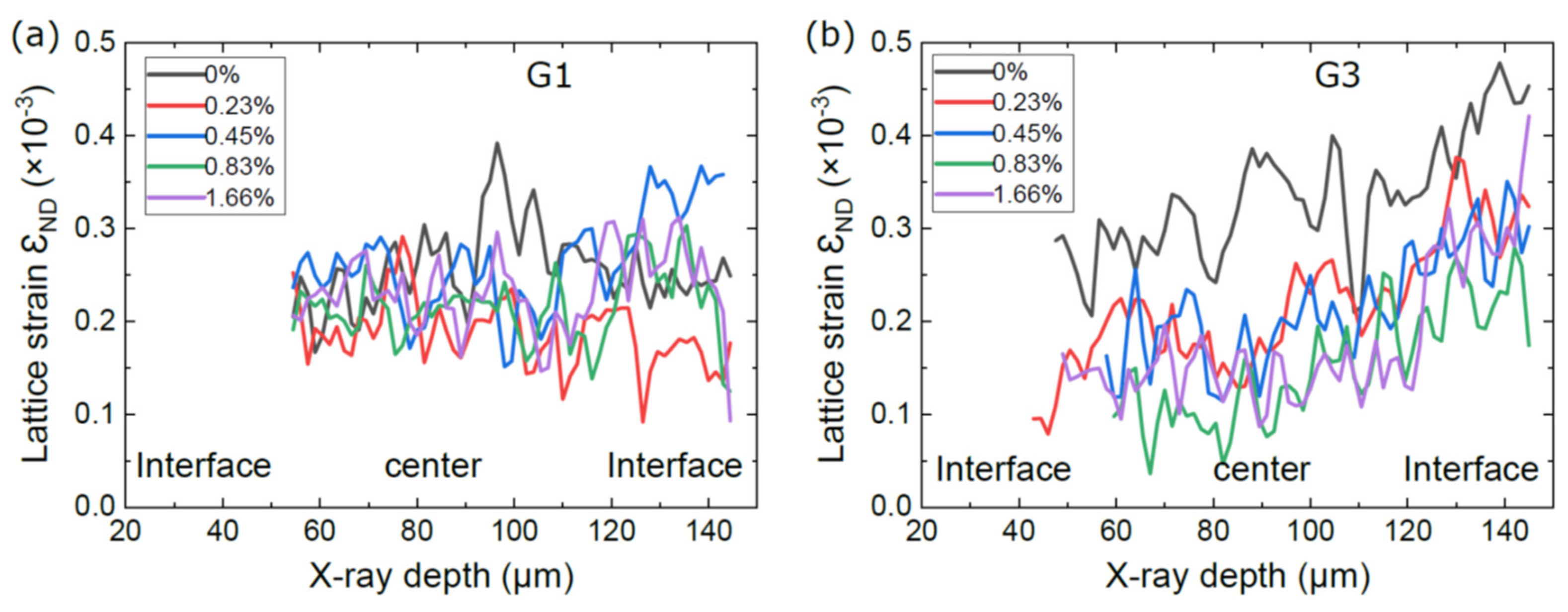
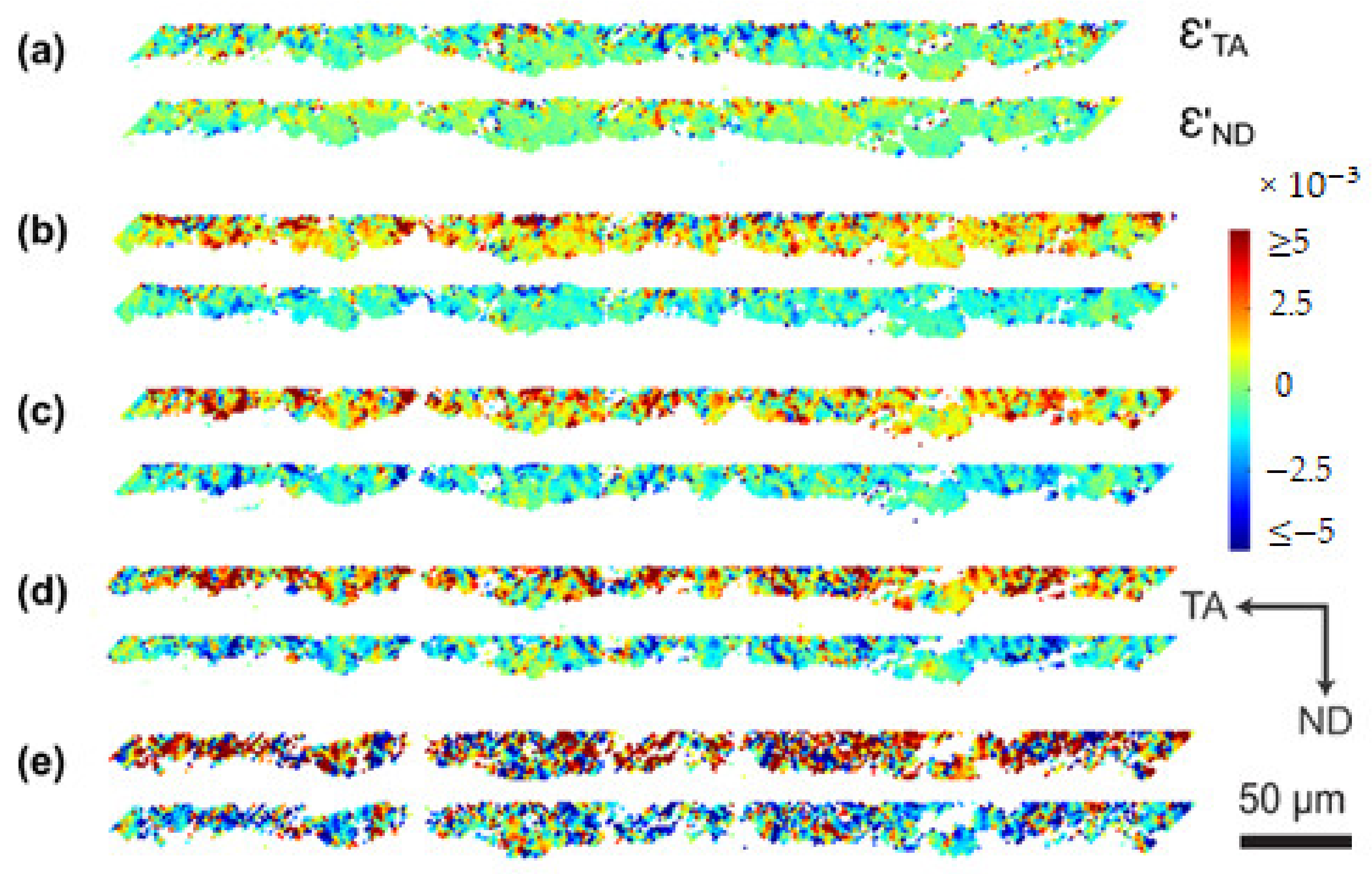
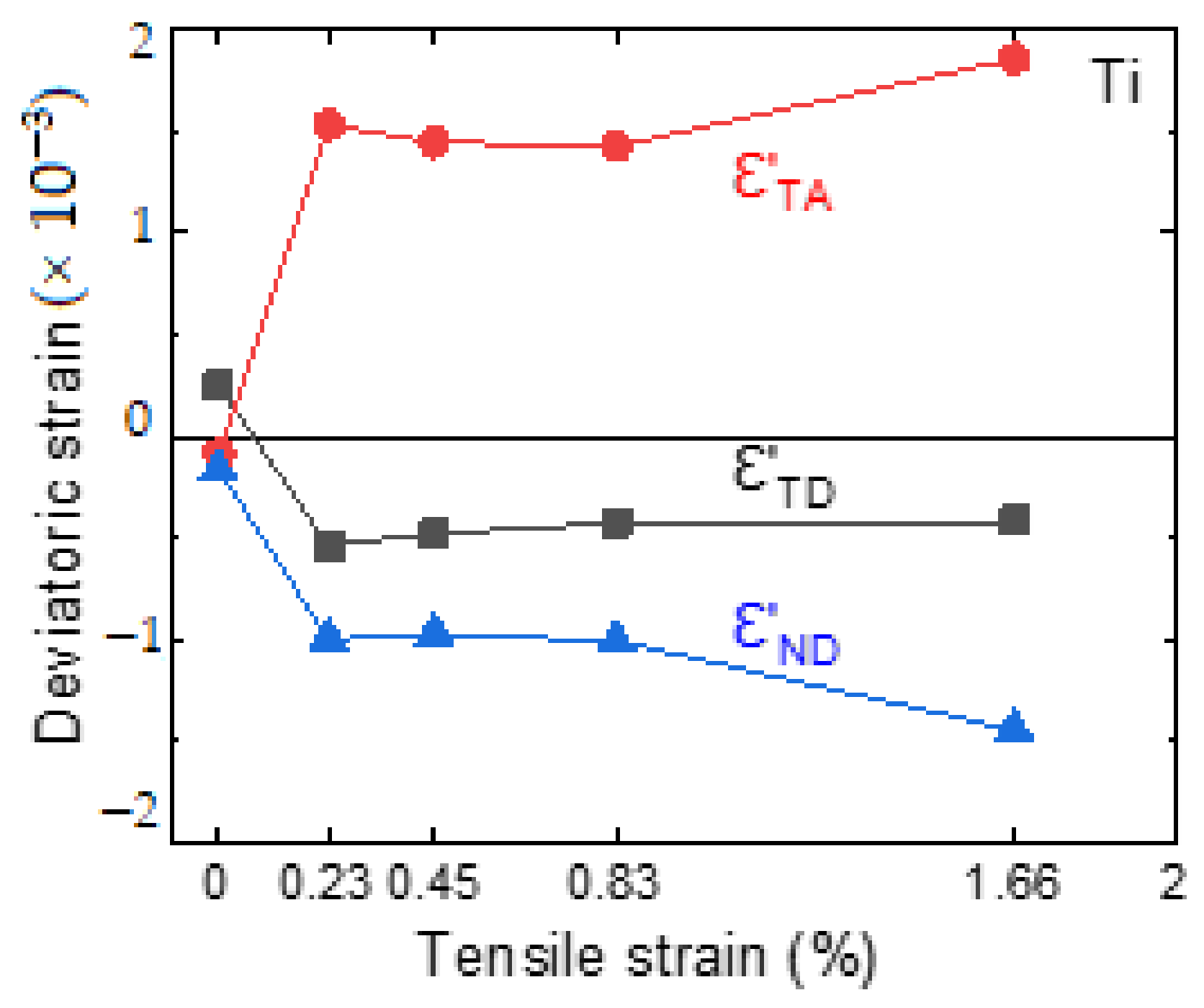
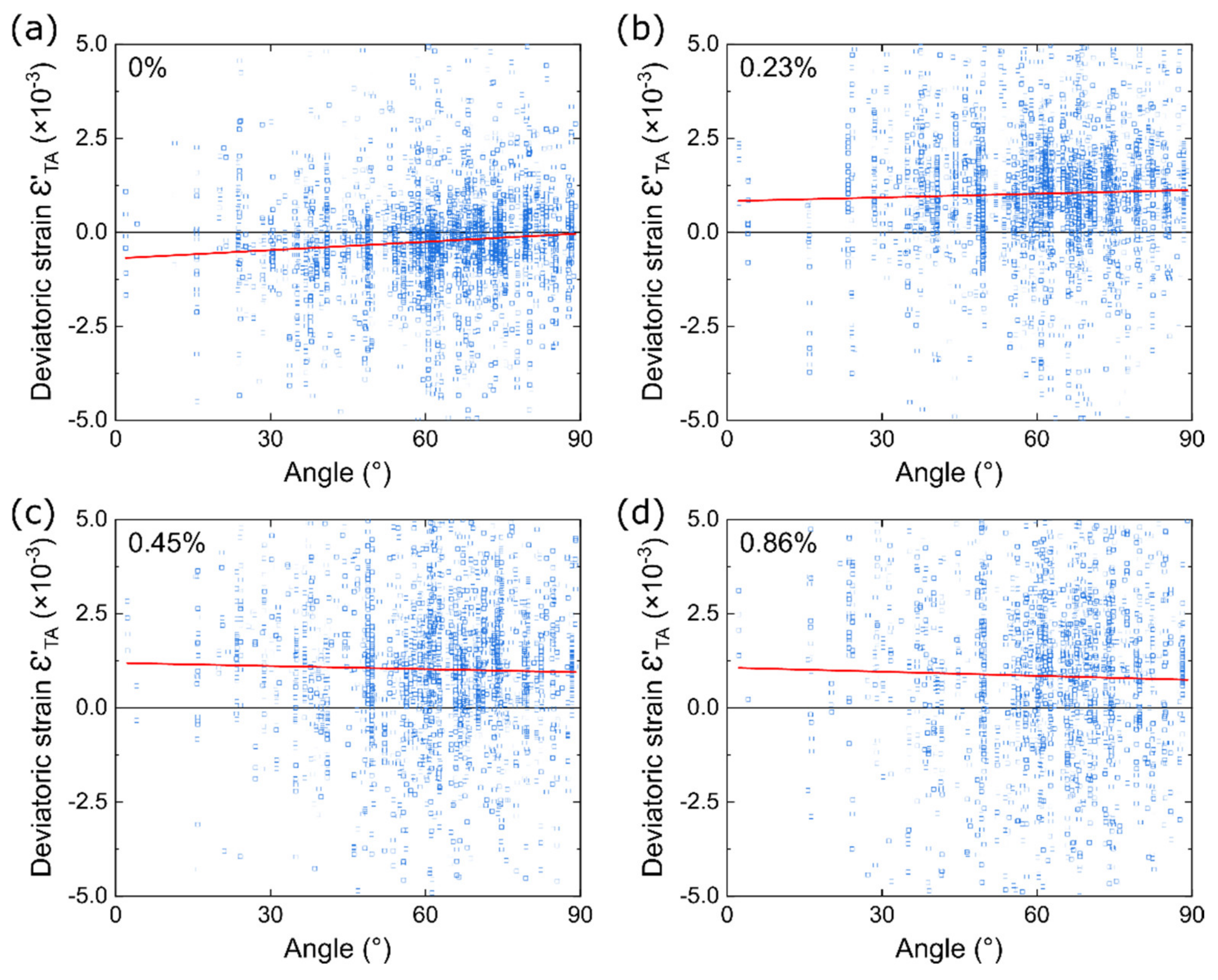
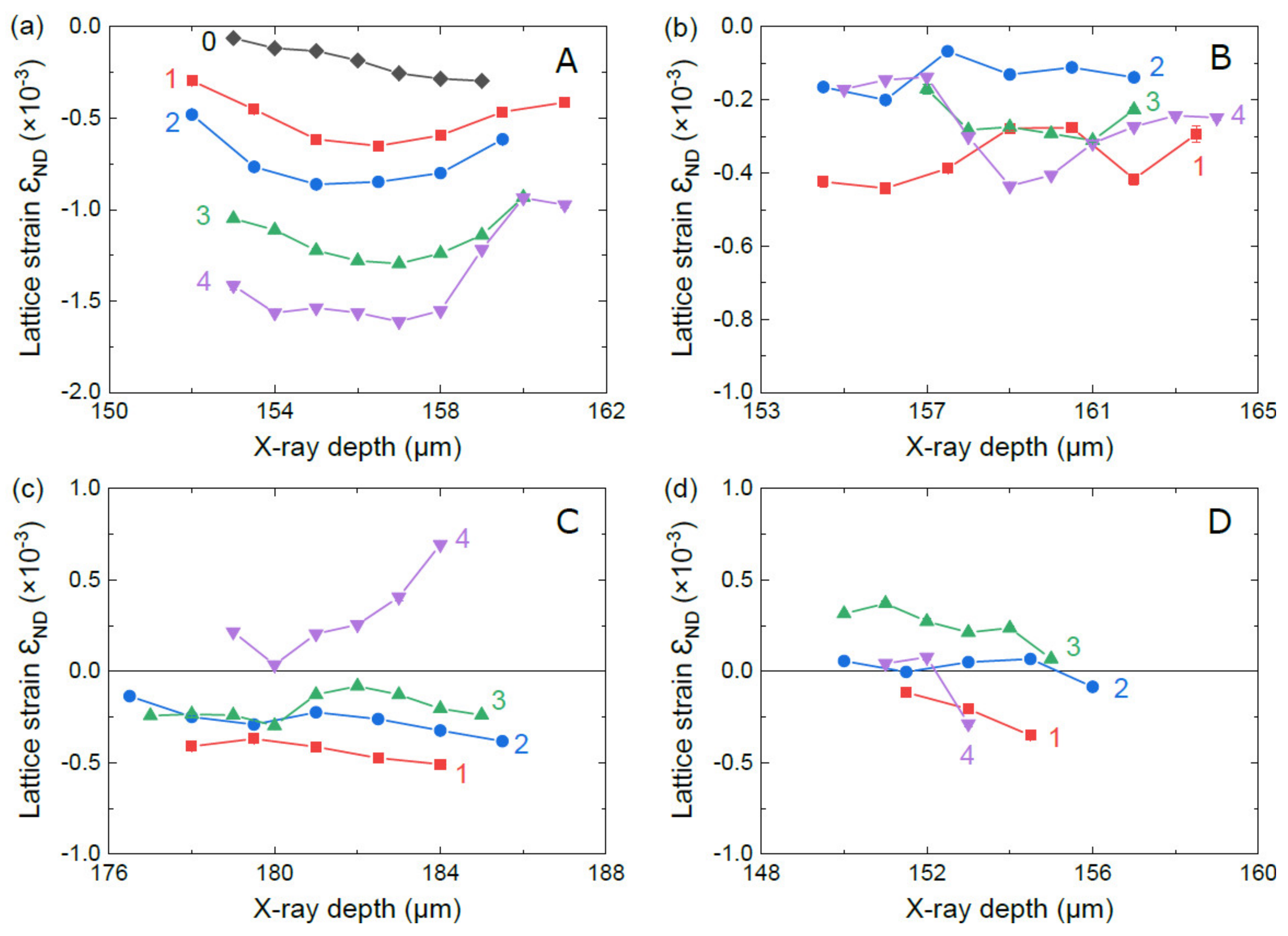
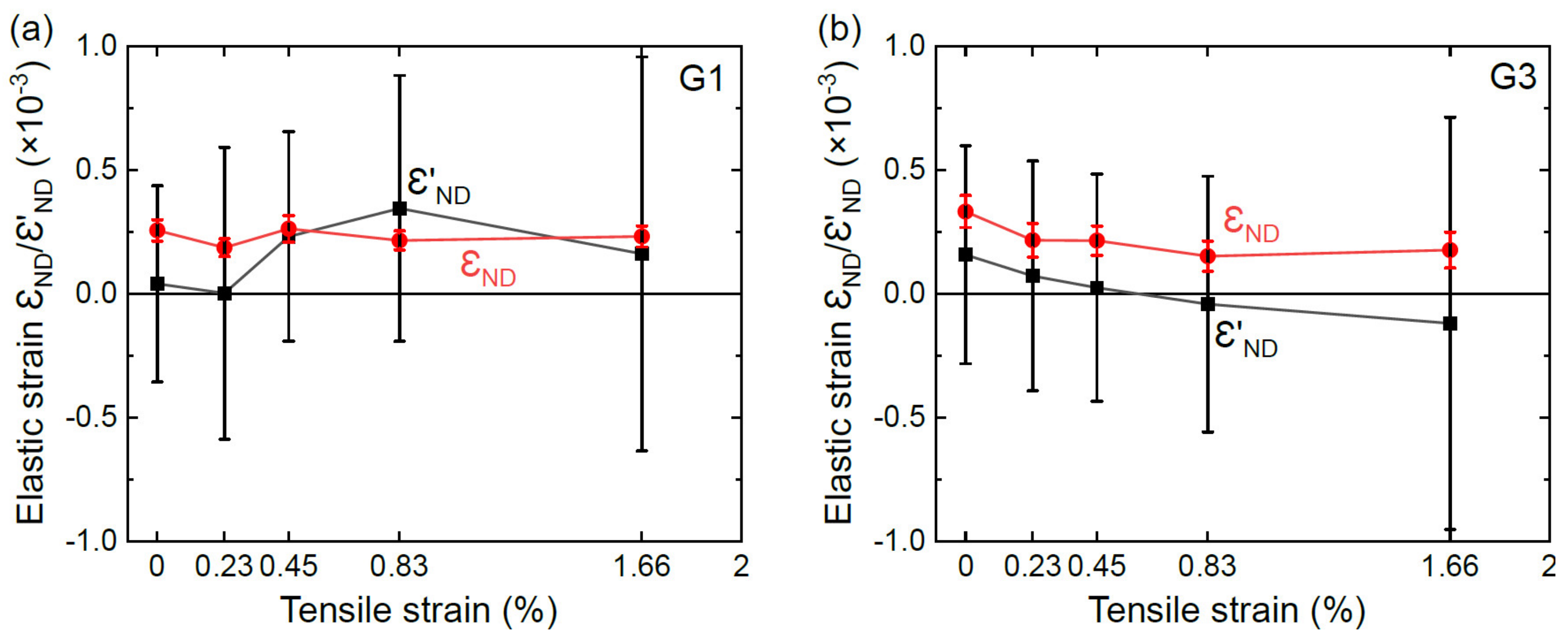
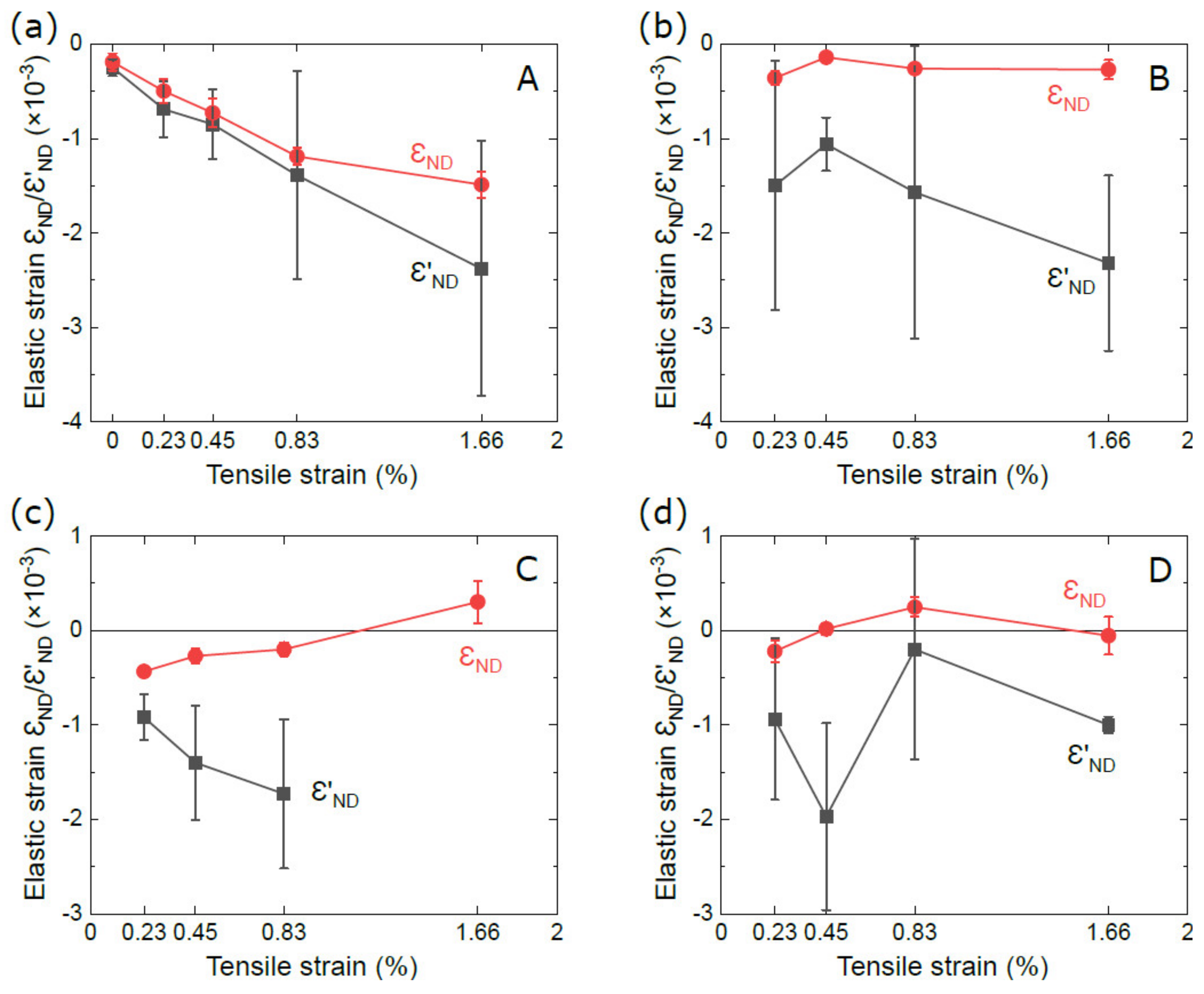
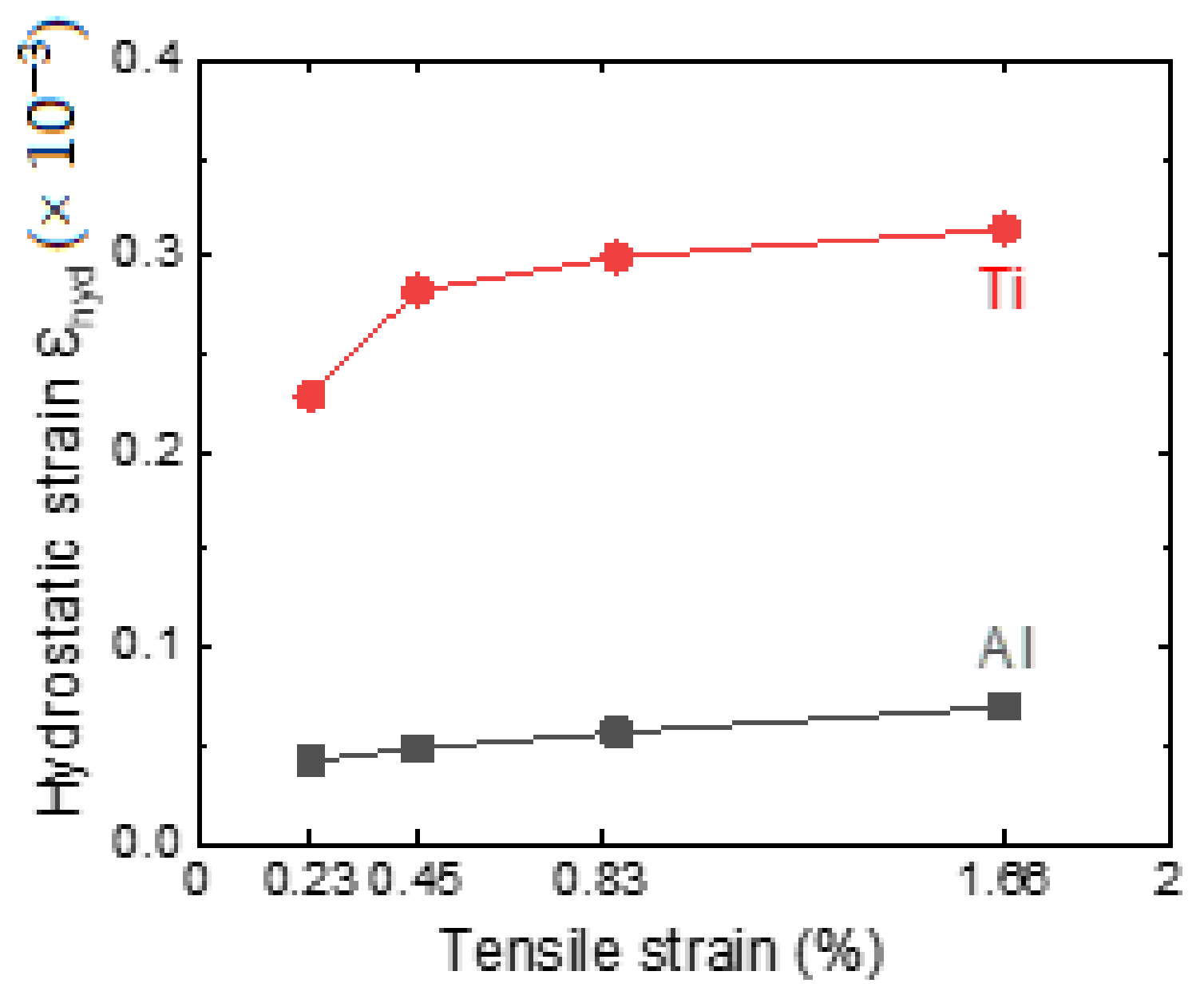
Publisher’s Note: MDPI stays neutral with regard to jurisdictional claims in published maps and institutional affiliations. |
© 2021 by the authors. Licensee MDPI, Basel, Switzerland. This article is an open access article distributed under the terms and conditions of the Creative Commons Attribution (CC BY) license (https://creativecommons.org/licenses/by/4.0/).
Share and Cite
Yu, T.; Du, Y.; Fan, G.; Barabash, R.; Juul Jensen, D.; Zhang, Y. In Situ Synchrotron X-ray Micro-Diffraction Investigation of Elastic Strains in Laminated Ti-Al Composites. Metals 2021, 11, 668. https://doi.org/10.3390/met11040668
Yu T, Du Y, Fan G, Barabash R, Juul Jensen D, Zhang Y. In Situ Synchrotron X-ray Micro-Diffraction Investigation of Elastic Strains in Laminated Ti-Al Composites. Metals. 2021; 11(4):668. https://doi.org/10.3390/met11040668
Chicago/Turabian StyleYu, Tianbo, Yan Du, Guohua Fan, Rozaliya Barabash, Dorte Juul Jensen, and Yubin Zhang. 2021. "In Situ Synchrotron X-ray Micro-Diffraction Investigation of Elastic Strains in Laminated Ti-Al Composites" Metals 11, no. 4: 668. https://doi.org/10.3390/met11040668
APA StyleYu, T., Du, Y., Fan, G., Barabash, R., Juul Jensen, D., & Zhang, Y. (2021). In Situ Synchrotron X-ray Micro-Diffraction Investigation of Elastic Strains in Laminated Ti-Al Composites. Metals, 11(4), 668. https://doi.org/10.3390/met11040668






